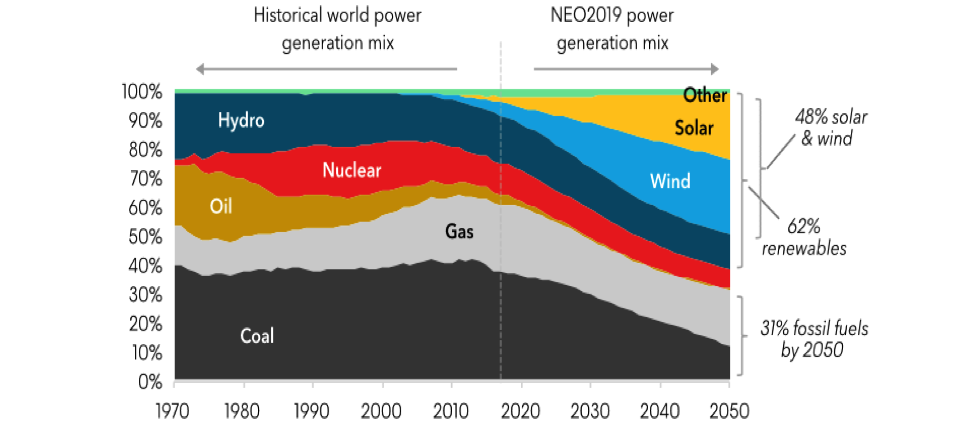Bloomberg’s New Energy Outlook 2019 projects that coal and nuclear resources will be greatly reduced from the generation mix by 2050, mainly as a result of “age and economics.” The report is a product of Bloomberg’s New Energy Finance research group, which studies, reports on, and is supported by those in the business of renewable energy. According to their report, renewable generation will supply 62 percent of the world’s electricity in 2050 with wind and solar power having a 48 percent share from 7 percent today. (See graph below.) According to Bloomberg’s report, “cheap renewable energy and batteries fundamentally reshape the electricity system.” Bloomberg projects that solar power will increase from about 2 percent of current world electricity supply to about 22 percent by 2050. Fossil fuels are projected to drop their share from over 70 percent of world electricity supply to 31 percent by 2050. Coal drops from 37 percent of the global power mix to 12 percent by 2050. The shares of hydro, natural gas, and nuclear remain roughly level on a percentage basis.
Global Electricity Generating Mix

According to the BP Statistical Report of World Energy, renewable energy led the growth in global power generation in 2018, followed by coal. Fossil fuels accounted for almost half the total world growth in the power sector. (See graph below.) Generally, once a power plant has been built, owners keep it running as much as possible to cover its cost and make a profit. According to Bloomberg, because wind and solar power are manufactured forms of energy, their costs have has fallen rapidly.
Bloomberg calculates that the levelized costs of electricity from wind and utility-scale solar power have dropped by 49 percent and 85 percent, respectively, since 2010. Bloomberg believes that wind and solar power are now cheaper than power from a new coal or gas-fired plant across two-thirds of the world, up from less than 1 percent only five years ago. Bloomberg expects that solar photovoltaic modules, wind turbines and lithium-ion batteries will continue on aggressive cost reduction curves, of 28 percent, 14 percent and 18 percent, respectively for every doubling in global installed capacity.
Change in global electricity generation, 2018
According to the Bloomberg report, the global economy will become increasingly electrified, not just in the power sector but across transportation, heating and cooling, increasing electricity demand by 62 percent and leading to almost a tripling of capacity by 2050. Over $13 trillion of investment will be needed in new generating plants, of which wind represents $5.3 trillion and solar $4.2 trillion. In addition to the spending on new generating plants, $840 billion will be spent on batteries and $11.4 trillion on grid expansion.
Bloomberg’s New Energy Outlook assumes that annual global carbon dioxide emissions in the generating sector have peaked in 2018 and projects them to decline by more than a third through 2050.
Bloomberg believes that renewable energy deployment is happening so quickly that it will put the world on track to limit global temperature rises to 2°C by 2030. But, remaining on that path to 2050 will be much more difficult because while Bloomberg believes wind and solar can reach 80 percent of the electricity generation mix in a number of countries by mid-century with the help of batteries, going beyond that it indicates will be problematic. Other technologies, such as carbon capture and storage, green hydrogen-to-power, biogas-to-power and nuclear, will be needed.
Europe
Europe will be the leader in decarbonizing its power system, with 92 percent of its electricity supplied by renewables in 2050. Major Western European economies, Bloomberg believes, are already on a trajectory to an almost no-emissions power system due to the European Union’s Emissions Trading System and policy support.
United States
The United States follows Europe’s lead, but due to its low-priced natural gas, it decarbonizes at a slower pace. According to Bloomberg’s Outlook, in the United States, a large fleet of relatively young natural gas-fired plants using inexpensive shale gas keep natural gas competitive with new renewable projects until the 2030s. Shale gas plays a key role in reducing U.S. carbon dioxide emissions thus far by helping to displace coal-fired power. Bloomberg expects the United States to invest $1.1 trillion in new power capacity, with renewables more than doubling their generation share to 43 percent in 2050.
China
China also follows at a slower pace than Europe due to its large fleet of coal-fired plants. Bloomberg expects China’s power sector emissions to peak in 2026, and then decline by more than half in the next 20 years. Capacity utilization of China’s coal fleet was above 50 percent last year for the first time since 2014, with the entire fleet expanding by 39 percent in that period. Because existing coal or gas-fired plants are run if they can cover their operating costs, Bloomberg does not expect solar power to undercut existing coal plants in China before 2027.
Asia
Bloomberg expects Asia’s electricity demand to more than double to 2050. The entire Asia Pacific region will account for almost half ($5.8 trillion) of all new capital spent globally to meet the increase in demand. China and India together will invest $4.3 trillion. China plays a large role in financing new coal-fired plants in Asia.
Conclusion
Bloomberg’s New Energy Outlook 2019 is very optimistic about the cost declines of wind, solar, and batteries and believes that renewable energy can generate 62 percent of the world’s electricity by 2050 and possibly more. As a result, the share of fossil fuels in the world’s electricity mix declines over time in its forecast.
For another view of wind and solar costs vs. existing generating resources in the United States, see IER’s report on The Levelized Costs of Electricity from Existing Generating Resources.